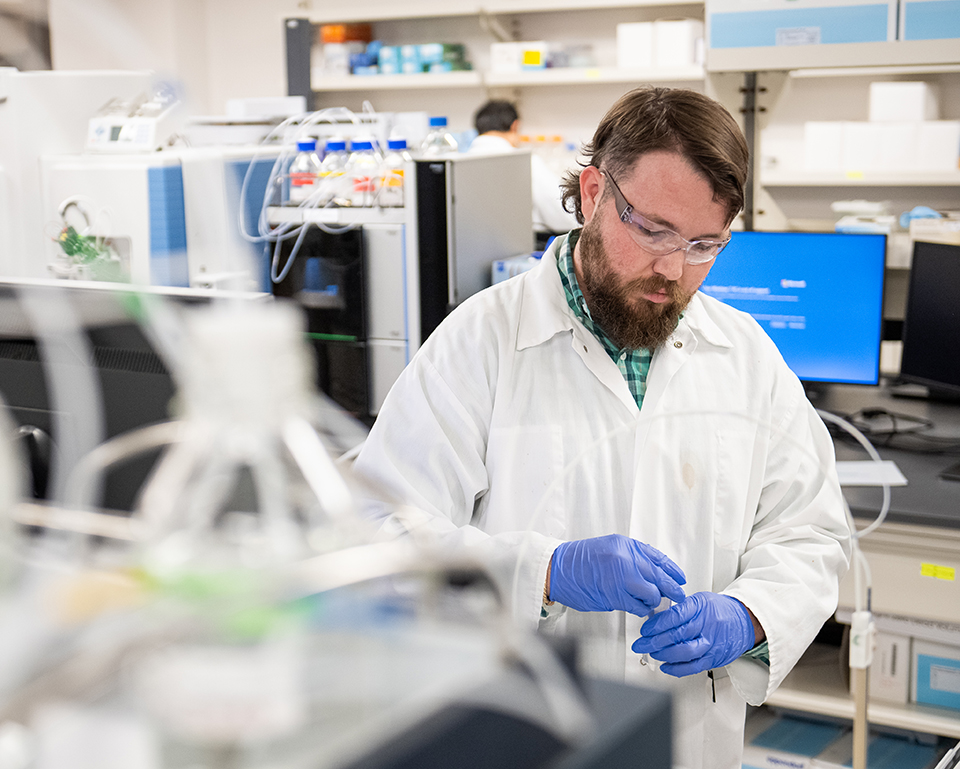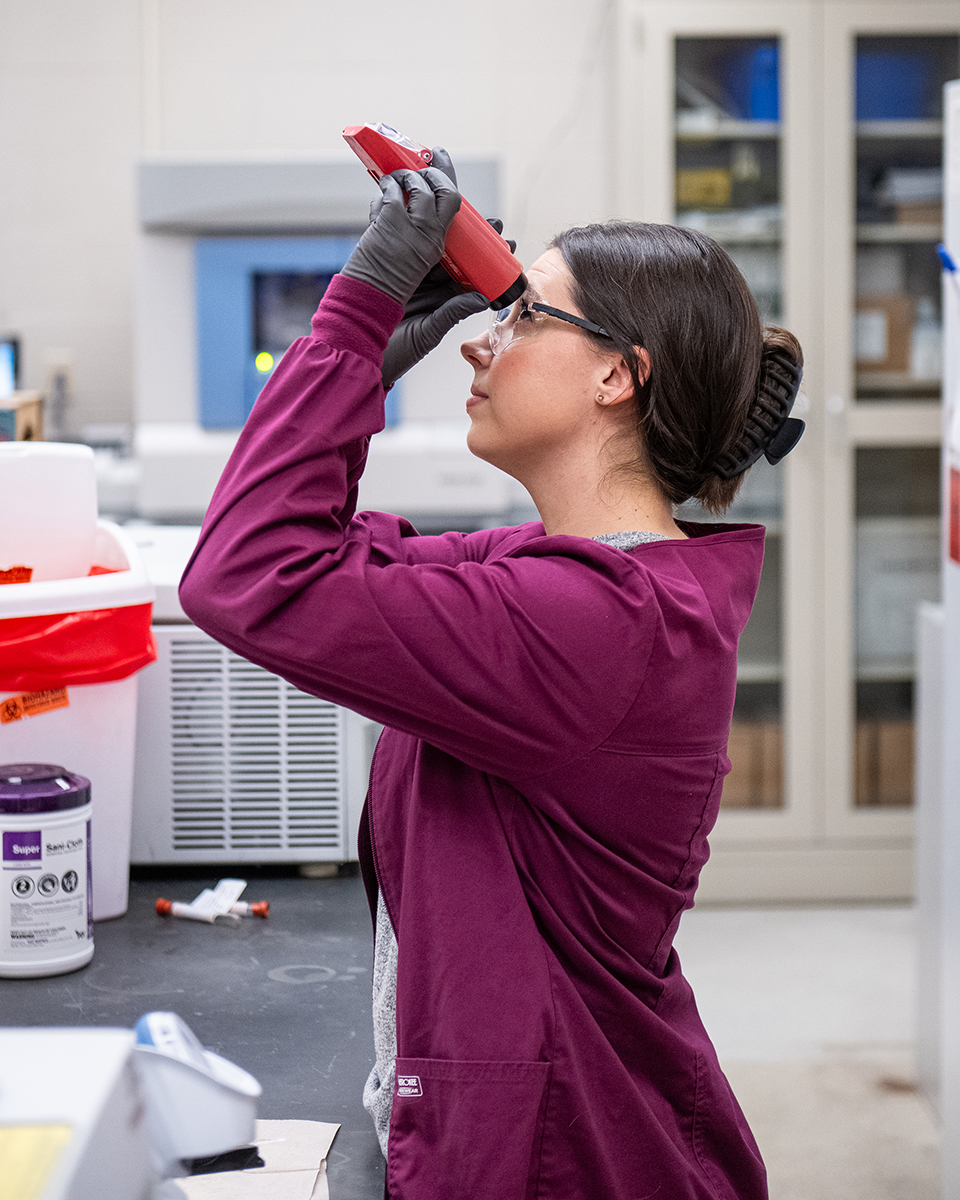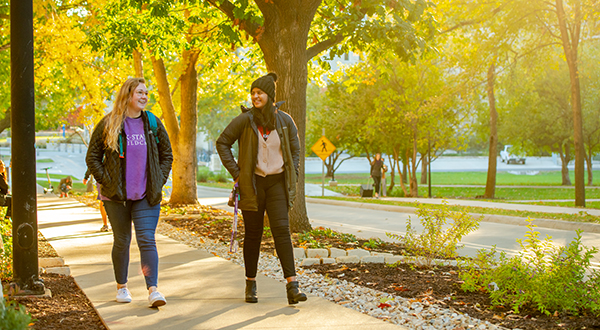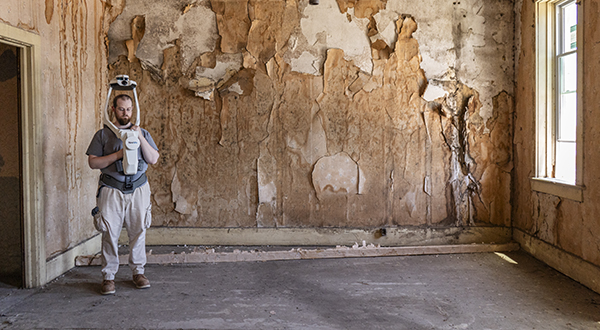Veterinary Diagnostic Laboratory
The KSVDL is the state’s front-line defense against devastating animal diseases
 Brad Hill, diagnostic technician in the Kansas State Veterinary Diagnostic Laboratory's toxicology laboratory, loads a sample on the Inductively Coupled Plasma Mass Spectrometer, or ICP-MS, for a bovine trace mineral panel.
Brad Hill, diagnostic technician in the Kansas State Veterinary Diagnostic Laboratory's toxicology laboratory, loads a sample on the Inductively Coupled Plasma Mass Spectrometer, or ICP-MS, for a bovine trace mineral panel.
 By Rafael Garcia
By Rafael Garcia
K-State News and Communications Services
The samples that could determine the fate of Kansas’ economy come to a small backroom at the back of Kansas State University’s College of Veterinary Medicine at dusk and dawn, as they do at midday and midnight.
They come hand-delivered by courier or in nondescript packages and United States Postal Services mailers.
They come alongside other biological matter — individual samples of cancer in cats and viruses in dogs — all with varying levels of importance but certainly no lack of urgency.
Because no matter the scope or scale, with animal lives on the line, nothing matters more than accurate and timely test results at the Kansas State Veterinary Diagnostic Laboratory, or KSVDL.
As the state’s largest and only public veterinary diagnostics lab, the KSVDL is the laboratory clearinghouse that veterinarians around the state and country know and rely on to diagnose and track the diseases that could wreak havoc on individual households and the U.S. agricultural economy at large.
“We serve so many people here, and we have many resources to help people with a wide range of animal issues,” said Jamie Retallick, director of the KSVDL. “We have people with zoo and wildlife backgrounds, people with poultry backgrounds, people with swine backgrounds — and that’s just down the hall. There are all of these resources here to help, and we do this work often in the background.”
Logistics of large-scale animal disease testing
Few kinds of professional schools are as wide-ranging as veterinary medicine, and the same holds true for the battery of diagnostic testing necessary to support the profession.
Imagine all the kinds of testing a human might see in health care — from virology to bacteriology to toxicology. Now imagine that same gamut of testing for various kinds of animals, including small companion animals like cats and dogs, large animals like cattle and swine, and zoo and exotic animals like elephants and orangutans.
That’s why the KSVDL’s staff members —including faculty, professional staff and veterinary students, residents and interns spread across more than a dozen specialized departments in three facilities on the north end of K-State’s campus — conduct more than 500 types of tests for clients.
Veterinarians and animal producers in all 50 states and 52 countries send hundreds of samples to the KSVDL each day, usually by overnight freight but sometimes by hand delivery.
It’s a huge logistical undertaking, but it’s one that the KSVDL is well-prepared and trained to accommodate, especially when it has practice processing thousands of animal tests in a short timeframe. The lab is also equipped to handle some human sample testing, and it was called into action in 2020 to help process COVID tests and provide relief to the Kansas Department of Health and Environment’s state lab in the first few months of the pandemic.
 Jennifer Rogosch and Sarah Ochoa Sanchez, diagnostic technicians in the KSVDL’s rabies virus laboratory, work on Fluorescent Antibody Virus Neutralization assays, which are used to measure animals‘ level of protection against the rabies virus.
Jennifer Rogosch and Sarah Ochoa Sanchez, diagnostic technicians in the KSVDL’s rabies virus laboratory, work on Fluorescent Antibody Virus Neutralization assays, which are used to measure animals‘ level of protection against the rabies virus.
Additionally, the KSVDL, through its necropsy unit, is often called to help determine why animals died. This can be as part of criminal or insurance investigations, but it can also be at the request of pet or livestock owners who want peace of mind or need to know to ensure they or their other animals aren’t also at risk.
Although much of its work entails practical testing of real-world samples, the laboratory also conducts and supports other K-State research and performs research to develop new tests to serve clients — studying both the pathogenesis of disease and epidemiology of animal disease spread.
With the KSVDL’s extensive selection of instrumentation and diverse faculty expertise, it bolsters various areas of research, ranging among infectious disease, cancer, water quality, toxins and others.
The wide range of KSVDL services and testing add to several of K-State’s efforts in biosecurity, including advancing diagnostics, prophylactics and therapeutic countermeasures for combating infectious animal diseases. Through surveillance, testing and research, the KSVDL emphasizes work to protect against zoonotic and foreign animal diseases that threaten animal agriculture, the food supply and human health.
For example, KSVDL faculty and staff worked alongside researchers to help them complete COVID research studies early in the pandemic, while researchers also helped with COVID testing by the KSVDL. Diagnostics and research are intimately intertwined and share many of the same skill sets.
“Both research and diagnostics are foundational sciences that lead to discovery of new knowledge important for meeting the land-grant mission of increasing knowledge for the well-being of all people,” Retallick said. “It is important for the KSVDL to perform and collaborate in areas of research as it contributes to scientific knowledge and better diagnostic testing to serve all clients, including researchers.”

Protecting US animals
Much of the KSVDL’s lab is the routine but important work of providing diagnostic testing for small animal veterinarians. Think toxicology panels for cats that have gotten into something they shouldn’t have or histological testing on masses removed from the skin of dogs.
Hunters also directly submit samples of deer tissue to monitor for chronic wasting disease as it ebbs around the state.
“There might be kids who are showing animals at the 4-H fair, but few people know that to go to that fair, they had to have certain animals tested, and we did that for them,” Retallick said. “We stand quietly behind those kids so that they can participate in those kinds of activities.”
But one of the most important roles the KSVDL plays is surveilling for and responding to any potential outbreaks of foreign animal diseases on Kansas soil.
The KSVDL is a member of the U.S. Department of Agriculture’s National Animal Health Laboratory Network, which monitors for outbreaks of diseases, such as African swine fever and foot-and-mouth disease, that could lay ruin to the nation’s livestock industry.
Not to be confused with the hand, foot and mouth disease that affects humans, foot-and-mouth disease primarily affects cloven-hoofed animals like cattle and swine. While not necessarily deadly, the highly infectious virus leads to fever, blisters and weight loss and leaves animals weakened for months.
 Alyssa Friesen, diagnostic technician in the KSVDL's bacteriology laboratory, loads a target into the MALDI-TOF mass spectrometer for rapid identification of microorganisms, primarily bacteria, from clinical samples submitted to the laboratory. The machine can turn around results in less than a minute, compared to the dayslong process of more standard chemical reaction testing.
Alyssa Friesen, diagnostic technician in the KSVDL's bacteriology laboratory, loads a target into the MALDI-TOF mass spectrometer for rapid identification of microorganisms, primarily bacteria, from clinical samples submitted to the laboratory. The machine can turn around results in less than a minute, compared to the dayslong process of more standard chemical reaction testing.
“We say it is not if a foreign animal disease outbreak will happen — it’s when,” Retallick said. “There will someday be an outbreak, and as a part of that network, we know we’ll be put into action to test samples.”
While more than 70% of the world has seen foot-and-mouth disease in the past couple of decades, the U.S. has been free of the virus since 1929.
That’s thanks in large part to aggressive border customs and surveillance efforts, said Justin Smith, animal health commissioner at the Kansas Department of Agriculture.
“Kansas has a huge livestock industry, and with it, a tremendous amount of movement. That makes us vulnerable to a lot of disease incursions, and one of our greatest fears is a foreign animal disease like foot-and-mouth disease,” Smith said. “Foot-and-mouth disease would severely cripple the nation’s ability to trade with other countries.”
Smith’s office and state veterinarians positioned around Kansas work directly with local livestock producers, feedlots and slaughterhouses to immediately sample and test any suspected cases of foot-and-mouth disease, as well as other regulatory or reportable animal diseases, and send them to the KSVDL to get tested — be it during business hours or at 2 a.m.
It’s both quality and health assurance, Smith said.
“There is a lot of routine surveillance for common diseases that allows us to ensure that Kansas’ livestock industry is healthy and that people want our products,” Smith said. “They serve not just Kansas, but a lot of surrounding states and industry, and they are the tip of the iceberg in terms of diagnostic work.”
A growing demand
For more common but still serious diseases, the KSVDL regularly publishes reports, maps and trends of animal diseases around the state, said Gregg Hanzlicek, clinical professor and director of production animal field investigations.
Hanzlicek also helps facilitate the lab’s outreach and continuing education efforts, which include regular webinars, newsletters and visits to counties around the state.
“It helps our veterinarians be more aware of things that might be changing in the environment or in the industries they work in, and from there, they help the producers manage and prevent numerous diseases,” he said.
Megan Potter, a veterinary clinician and part-owner at Abilene Animal Hospital, said that local practitioners like her often have an idea of what a certain case might be before sending it to the KSVDL for testing. The tests provide both confirmation and peace of mind, as well as expertise on the latest trends and strains of diseases.
“They get a wide variety of cases, so you get out of your local area a bit,” she said. “And you can draw on the information that the diagnostic lab has gained from other clinicians.”
In the past couple of decades, the KSVDL has grown dramatically from a pool of about 10 faculty and 50 staff to 22 faculty and about 100 staff, mostly to manage a caseload that has more than doubled to more than half a million tests per year.
That can be a difficult feat, especially since most other similar state veterinary laboratories around the country are based in a single facility. The KSVDL has to shuttle samples between laboratory spaces in three separate buildings on the north end of the university’s campus.
Retallick said the surge in casework has largely been because of an increased awareness and desire to prevent disease outbreaks like highly pathogenic avian influenza.
“The animal agriculture industry is more proactive about potential diseases, and if there is something that exists in their facilities, they want to know exactly what it is before it becomes an outbreak,” Retallick said.
“There’s also the fact that pets are a bigger part of families, and their owners want the same level of care and testing they might get for a family member,” she added. “More pets and animals are also traveling, and to go into a certain country, you might need specific tests to be done.”
 Mabel Wen Todd, medical technologist in the Kansas State Veterinary Diagnostic Laboratory's clinical pathology unit, loads a sample on the Stago Compact Max Coagulation Analyzer, which measures blood clotting times.
Mabel Wen Todd, medical technologist in the Kansas State Veterinary Diagnostic Laboratory's clinical pathology unit, loads a sample on the Stago Compact Max Coagulation Analyzer, which measures blood clotting times.
The KSVDL’s rabies laboratory also processes titer tests from several foreign countries, predominantly in Latin America — with the laboratory even staffing a Spanish-language hotline for veterinarians from those countries.
Despite the growth in testing, the KSVDL has remained largely self-supported. The laboratory receives some state funding to support salaries, and some federal grants help cover foreign disease surveillance, but most of the KSVDL’s revenue comes from the nominal fees it charges clients for testing.
But beyond low prices and rapid test turnaround times, the most important reason the KSVDL has built its reputation around the state, nation and world is its communication with clients, Hanzlicek said.
“When they call us, they get a hold of someone who is an expert in the lab and can talk them through their cases,” Hanzlicek said. “Someone is always available and willing to answer questions.”


